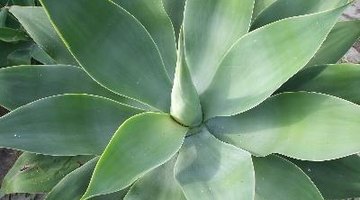What's the Difference Between Light & Dark Agave Nectar?
Blue agave, the same spiky desert plant that yields tequila, also provides the juice for agave nectar. Called the "maple syrup of the desert," both light and dark agave nectars are sweet alternatives to more traditional sweeteners like table sugar, honey and corn syrup. Differences in processing produce the two colors of agave nectar. Each type has its own uses, whether for sweetening beverages or adding to baked-good recipes.
Manufacture

Manufacturers crush the agave plant's succulent leaves to extract the sap, then cook the sap at about 140 degrees Fahrenheit for three days to thicken it into a sweet syrup. The amount of filtration determines the color. Dark agave nectar gets its brown hue from light filtration, which retains many of the natural minerals. Light agave undergoes a finer filtration that removes much of the syrup's mineral content, resulting in an amber color.
Taste
Both light and dark agave nectars get their sweet taste from fructose, a type of sugar. In addition to its sweetness, dark agave nectar has a vanilla-like taste and aroma. Light agave nectar has a milder taste and a more neutral aroma. The stronger-flavored dark agave nectar makes a good alternative to syrup on pancakes and waffles; the more delicate light agave will not overpower the flavor of beverages, fruits and baked goods.
Nutrition
Both light and dark agave nectars have the same nutrition content. They contain 16 calories and 4 grams of carbohydrates per teaspoon. The calorie content is about the same as a teaspoon of table sugar, but agave nectar is sweeter than sugar. That added sweetness means you can use less agave nectar in beverages and recipes that call for sugar. Glenda Kinder, a nutrition and health education specialist for the University of Missouri Extension Service, advises using one-fourth the amount of agave when substituting for sugar in a recipe.
Benefits
Agave nectar manufacturers advertise their product as a healthy, natural sweetener. However, both light and dark nectars contain 50 percent fructose, compared to 50 percent for honey and 55 percent for high-fructose corn syrup, according to FoodProcessing.com. Agave nectars do have a relatively low glycemic index (GI) of between 20 and 30, compared to 55 for honey and 68 for table sugar. The lower GI means that agave nectar raises blood-sugar levels more slowly. The American Diabetes Association says agave nectars are safe for diabetics, but should be used in moderation.
References
Resources
Writer Bio
Cameron Delaney is a freelance writer for trade journals and websites and an editor of nonfiction books. As a journalist, Delaney worked for wire services, newspapers and magazines for more than 20 years. Delaney's degrees include a bachelor's degree in journalism from Pennsylvania State and a master's degree in liberal arts from University of Denver.
Photo Credits
- agave image by robert casacci from Fotolia.com
More Articles



